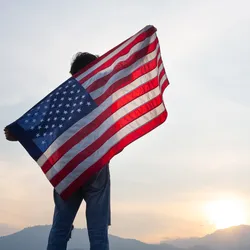
On March 3rd, 1931, “The Star-Spangled Banner” officially became the United States’ national anthem. The adoption of the anthem came after a long and contentious debate about which song should represent the country.
Before the adoption of “The Star-Spangled Banner,” several other songs were used as unofficial anthems, including “Hail, Columbia” and “My Country, ‘Tis of Thee.” However, none of these songs gained widespread popularity, and there was a growing consensus that the country needed a national anthem.
In 1916, President Woodrow Wilson issued an executive order designating “The Star-Spangled Banner” as the official national anthem, but this order was largely ignored. It wasn’t until 1931 that Congress passed a resolution officially recognizing the song as the national anthem.
”The Star-Spangled Banner” was written by Francis Scott Key during the War of 1812. Key was aboard a British ship during the bombardment of Fort McHenry in Baltimore, and he was inspired by the American flag still flying over the fort at dawn.
The song quickly became popular among Americans, and it was often played at patriotic events. It gained even more prominence during World War I, when it was played at the beginning of every movie shown in theaters.
Despite its widespread popularity, “The Star-Spangled Banner” has also been the subject of controversy. Some people have criticized the song for its difficult vocal range and archaic language, while others have taken issue with its glorification of war.
Despite these criticisms, “The Star-Spangled Banner” remains an important symbol of American patriotism. It is played at the beginning of major sporting events, political rallies, and other important national occasions. And on March 3rd, we celebrate its adoption as our national anthem.
Simplified Story:
On March 3rd, 1931, the United States declared “The Star-Spangled Banner” as its national anthem. The decision came after much debate about which song should represent the country. Previously, several other songs had been used as unofficial anthems, but none gained widespread popularity. “The Star-Spangled Banner” was written by Francis Scott Key during the War of 1812 and became popular among Americans, particularly during World War I. Despite some criticism of the song’s difficult vocal range and outdated language, it remains an important symbol of American patriotism, played at major sporting events and political rallies.
Questions:
When was “The Star-Spangled Banner” officially declared as the United States’ national anthem?
What was the inspiration behind Francis Scott Key’s writing of “The Star-Spangled Banner”?
Were there any other songs used as unofficial anthems before “The Star-Spangled Banner” was adopted?
Do you think “The Star-Spangled Banner” is an appropriate representation of American patriotism? Why or why not?
In your opinion, what is the significance of “The Star-Spangled Banner” being played at major national events?
Vocabulary:
National anthem: a song that represents a country and is played on important national occasions.
Widespread: existing or happening over a large area or among many people.
Archaic: old-fashioned or outdated.
Glorification: the act of praising or honoring something or someone excessively.
Symbol: an object, word, or gesture that represents something else, often an idea or concept.
Image by jcomp on Freepik




